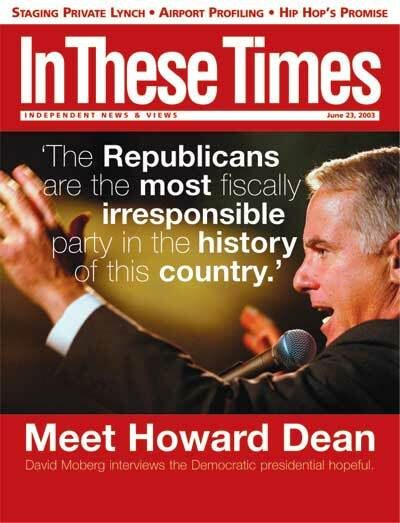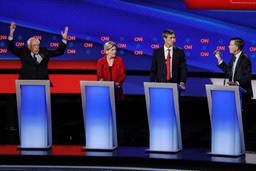But I just had a very eye-opening chat with Michael Powell, head of the FCC. And now I realize that Bob is just getting excited over nothing: He doesn’t grasp how progressive and democratic “market forces” can be, and he fails to understand that letting Rupert Murdoch’s News Corporation own as many media outlets as possible will ensure that Americans get to hear a true range of diverse voices.
Every time Bob has been on the radio or written yet another exposé about the dangers to democracy of ongoing media consolidation, I have to answer a lot of questions from students and friends. And now that the FCC is about to propose what the New York Times called “the most important rewriting of the ownership rules in decades,” some people have become curious about what that means. So let me try, again, to set the record straight.
Is it really true that the staff at the FCC has circulated a proposal that would nearly eliminate the limit on the number of TV stations a network could own?
Yes, the current rule is that no person or company can own stations reaching more than 35 percent of the country. The FCC would raise that to 90 percent.
Ninety percent? Doesn’t that mean that Rupert Murdoch could just go on a big shopping spree and buy scores of TV stations? Doesn’t that mean we’d have “The O’Reilly Factor” all the time? And endless right-wing blondes?
Well, Murdoch gives the people what they want. Besides, the 35 percent ownership cap infringes on Rupert’s free speech rights.
Come again?
Well, it’s true, some misguided people cite Supreme Court rulings, which argue that “the widest possible dissemination of information from diverse and antagonistic sources” is essential to preserving a public marketplace of ideas. But the 35 percent cap silences and oppresses Murdoch’s News Corporation. It makes it disadvantaged. Of course, convergence will help rectify such glaring inequalities.
Disadvantaged? I thought disadvantaged referred to, say, a poor person suffering from inadequate educational resources, health care, job opportunities, and housing.
Oh, that’s so ’60s. Today, disadvantaged refers to a company that has failed to acquire several TV networks, a cable company, production studios, 900 AM and FM stations, various online services, a long-distance telephone company, orbiting satellites, and the planet Jupiter.
What is convergence?
Convergence is like synergy, only better. Synergy is more spiritual (you know, like at AOL Time Warner). Synergy is the transcendental, binding arc of energy that radiates throughout the corporate media when two behemoths in the media industry seek to unite to clobber all known competition. Convergence is what happens in particular markets. And after the FCC has its way with the newspaper broadcast crossownership rule, TV stations will be able to buy newspapers in the same market, or vice versa. Murdoch has been the trailblazer here, since he already owns newspapers and TV stations in New York City.
Wait a minute. You mean that I could turn on the local news while leafing through my newspaper and have them owned and produced by the same people?
Yup. The economies of scale are beautiful.
But look at what Clear Channel has done to radio. Relaxing the ownership caps on radio stations has meant that Clear Channel can own the majority, if not all, of the stations in a town. Then they refuse to play music by artists who won’t pay their promotional fees, and they have actually banned certain bands from some stations. Not only have they totally wrecked radio—oh yeah, and try to get any news from their stations—but then they used all their money to stage those pro-war demonstrations.
Well, that’ s free speech and the beauty of competition.
That’s not competition. It’s a government sanctioned oligopoly that benefits the rich. Besides, as Gene Kimmelman of Consumers Union puts it: What if AOL Time Warner had owned the Washington Post and the leading TV station in Washington? Would they have covered how AOL falsely inflated its earnings? Kimmelman’s bet is no. What else does this FCC want to do?
Well, right now, there’s a cap—30 percent —on the number of cable systems in the country one entity can own. Who needs it? That just thwarts corporate free speech and competition. There’s the dual network rule, which prevents major networks like ABC or NBC from owning each other—that could go away.
Why have an FCC if it doesn’t impose and enforce regulations?
Michael Powell’s point exactly. Who needs an FCC when you have the market?
These seem like really huge changes. I don’t think ordinary people have any idea that the media could be controlled by even fewer corporations than run the show today. Shouldn’t there be public debate about this?
Michael Powell thinks that would be just silly and irrelevant. He already knows what Rupert wants. And what Rupert wants, Rupert gets. What’s to debate?
What’s Bob McChesney’s phone number again?

I hope you found this article important. Before you leave, I want to ask you to consider supporting our work with a donation. In These Times needs readers like you to help sustain our mission. We don’t depend on—or want—corporate advertising or deep-pocketed billionaires to fund our journalism. We’re supported by you, the reader, so we can focus on covering the issues that matter most to the progressive movement without fear or compromise.
Our work isn’t hidden behind a paywall because of people like you who support our journalism. We want to keep it that way. If you value the work we do and the movements we cover, please consider donating to In These Times.
Susan J. Douglas is a professor of communications at the University of Michigan and a senior editor at In These Times. She is the author of In Our Prime: How Older Women Are Reinventing the Road Ahead.








